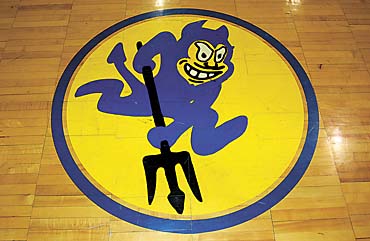SERVING CRAGSMOOR, ELLENVILLE, KERHONKSON, LACKAWACK, NAPANOCH, SPRING GLEN, ULSTER HEIGHTS, WAWARSING AND ALL NEIGHBORING COMMUNITIES | |||
| |||
|
A Devil Of A Time
Community Prepares For Discussion On Mascot
"You can't destroy the innocence of the "Boy with the Boot." These are the words of Mr. Jim Graham, a resident of the Ellenville Central School District who announced his intention to lead a charge to change the district's mascot from the Blue Devil to any number of possibilities including The Saints, The Big Blue or, working off the statue in Ellenville's Liberty Square, the Boy with the Boot.
Mr. Graham explained his reasoning for the proposed change during a telephone interview. Mr. Graham, an officer at a local corrections facility (he declined to say which one), moved to the area almost three years ago from Albany. He explains the initial reaction friends had when he told them he was thinking about moving to the area. "When I first thought about moving to the area, people told me to stay away. They said it [Ellenville] was full of prostitutes, drugs and alcohol. But I didn't see that." Having lived in the area for a while, Mr. Graham feels that part of the negative image that Ellenville has is based on the school's mascot. His argument is based on the idea that an area's image is an important part of the community as a whole. And because the school's athletic program is one of the area's key ambassadors to other parts of the region, what Ellenville students do, say and wear reflects on the entire community. Therefore, Mr. Graham is looking for the school to adopt a mascot with no negative connotations like an image such as a "devil" might have. He feels that another name would help redefine Ellenville as a town without so many vices. Furthermore, Mr. Graham feels that, "It [the Blue Devil mascot] doesn't tell you anything about the area or the culture." Thus, a mascot with a more regional flavor would also be a welcome change. Mr. Graham has found very little support. However, Dr. Richard Craft, president of the Ellenville-Wawarsing Alumni Association, told the Journal that he was never a big fan of the Blue Devil. Instead, Dr. Craft said that he would like a mascot that was more in keeping with the area's history. He suggested the Mountaineers or something to do with the D&H Canal as names more appropriate to the district. From casual conversation with many local residents, it seems likely that if the issue of a name change came to a referendum, the Blue Devils would have a convincing win. Mr. Graham and all interested persons will have their chance to speak out on Tuesday, November 28 at 7:00pm when the matter will be heard by Ellenville's School Board in the high school's media center.
Controversy often forces people to reevaluate why they think the way they do or how something got to be the way it is. So when Mr. Jim Graham raised the charge to change the Blue Devil on account of its negative image for the area, many people asked the question, "Where did the Blue Devil come from?" The Blue Devil, as a general symbol, appeared during World War I. The Chasseurs Alpins, which loosely translates to the "alpine hunters", was a group of French soldiers whose unique knowledge and training was valuable in breaking the stalemate of trench warfare. They were known as les Diables Bleus, "the Blue Devils", because of their tenacity and their blue uniform, which included a flowing cape and beret. When the United States entered the war, units of Blue Devils toured the country to raise money and support for the war effort. The most famous example of the Blue Devil mascot is the one worn by Duke University. Duke adopted the Blue Devil as mascot in 1923 when the school's newspaper, The Trinity Chronicle, started using the name to refer to the school's teams. The Blue Devil first came to Ellenville in 1938 when a young man named William Fleckenstein won the contest to name Ellenville's sports teams. Although this cannot be verified, it seems likely that, at the time of the contest, the story of the Blue Devils would have been known by Mr. Fleckenstein. The first instance of Ellenville's teams being referred to as Blue Devils appeared in the first incarnation of the Ellenville Journal in a January edition in 1938. The paper referred to the teams as the "Blue Devils", suggesting that it was still an unofficial name. Later on in that school year, the paper referred to the boys' basketball team, this time without quotation marks suggesting that the name was already adopted as the official news. Sadly, Mr. Fleckenstein was killed not long after he chose the mascot.
COMMENTS about this article (1364) Copyright © 2006, Electric Valley Media Corp. All Rights Reserved. |

|

